Target: All Tokyo Residents! How "Tokyo Disaster Prevention" Came to Be (Part 2)
Since September 2015, the " Tokyo Disaster Prevention " handbook has been distributed to every household in Tokyo. Last time, we learned that this handbook employs strategic communication design to ensure it doesn't just get distributed and forgotten, aiming to enhance residents' disaster preparedness and make disaster prevention activities part of daily life. This time, we hear about how this handbook was created and its future developments.

■Easy to grasp with a quick flip-through. Rewarding for a thorough read.
A structure accommodating diverse reading styles
—How did you decide on the book's structure?
Sakaki: We aimed for a disaster prevention book that could be grasped roughly in 30 minutes, offer deeper knowledge over a week, and be enjoyable for children while satisfying adults.
To achieve this, the basic page layout follows a simple structure: "Title," "Illustration," and "Detailed Explanation." For readers with low disaster preparedness literacy, the design ensures that even just flipping through the "Title" and "Illustration" sections allows basic knowledge to sink in.

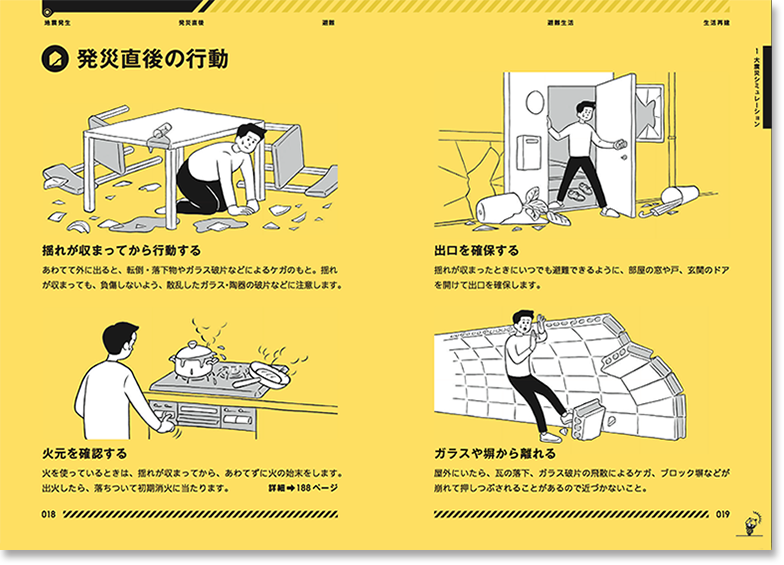

We made it so busy people can still get the essential information. Then, if you take time to read it thoroughly, you gain even more disaster prevention knowledge. That's the structure.
While we considered making it a dictionary-style book, we realized that if it could be read in any order, people might not read it at all. So, up to Chapter 1's simulation section, it's designed to be read as a narrative, like a story, and beyond that, it functions as a reference.
It also has the appeal of a readable narrative, allowing for deeper engagement over time. Columns are included at the end of each chapter. For example, Chapter 1 concludes with accounts from survivors of the Great Hanshin-Awaji Earthquake and the Great East Japan Earthquake, featuring interviews with people of various generations and backgrounds.
Furthermore, to enhance its dictionary-like searchability, we've strengthened the index. We've integrated the regional index, household index, and glossary, and made efforts to shorten the time it takes to find necessary information.

The digital version is also very well done.
Sakaki: Tokyo has the highest smartphone usage rate in Japan, so a digital version was essential. Led by UX designer Natsuki Matsuura from Dentsu Digital Inc. Creative Center, the digital version was completed in about a month after the book's content was finalized.
The digital version allows chapter-by-chapter downloads. While this approach received some criticism on Twitter, it was implemented to prevent server overload. The system is designed to withstand simultaneous access during critical moments.
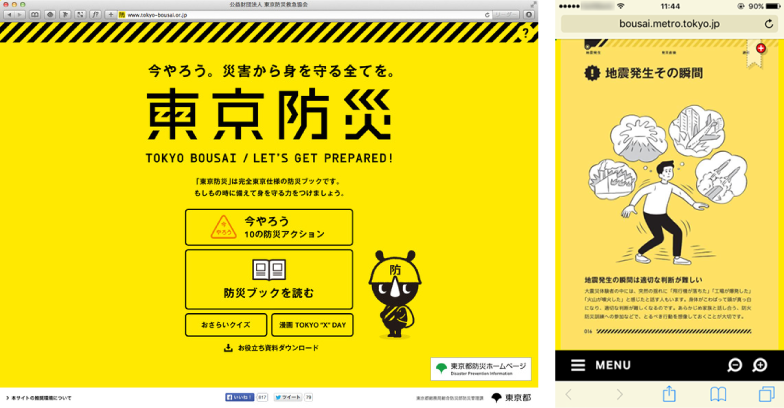
—The maps and cover are also very useful, right?
Sakaki: The cover enhances durability for carrying it out in an emergency. It also allows people to insert family photos. During disasters, when families are separated, photos convey information most effectively. Since power might be unavailable, analog photos are powerful.
Actually, it comes with a sticker too. People ask, "What's this?" But we don't just want to distribute this book and be done with it. We want it to spark a movement. That's why we encourage people to stick this sticker somewhere visible, like their front door mailbox, after reading it. We designed this as a way to visualize how people starting disaster preparedness actions in Tokyo are spreading the word.
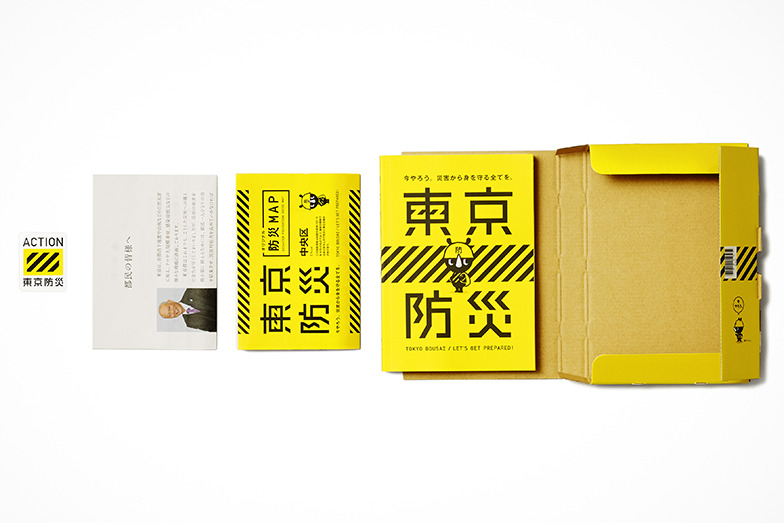
■A disaster preparedness book created by the entire team. Meticulous attention to detail gives it a distinctly Japanese finish.
—How did you create the book's content?
Sakaki: I oversaw the creative editing, but I don't have deep knowledge of disaster prevention itself. The staff at the Tokyo Metropolitan Government's General Affairs Bureau, Comprehensive Disaster Prevention Department possess an incredible amount of knowledge and experience. The team at Dentsu Inc. Business Creation Center helped organize the information and provided us with the key points to communicate.
They also provided very clear guidance on what content to include and what to exclude. Before entering the actual production phase, we conducted interviews with various experts—including academics, disaster prevention specialists, individuals with firsthand disaster experience, and those knowledgeable about children's disaster preparedness—to gather and stockpile the latest disaster prevention insights.
For the actual production, the design company Nozainer was deeply involved. This company advocates social innovation design. Their commitment to social contribution activities aligned with ours—they launched the disaster information sharing site "OLIVE" immediately after the Great East Japan Earthquake—and their design capabilities are exceptional. We met directly with their representative, Mr. Tachikawa, and invited him to join our team for this project. We also brought in the company Brain Ship to handle editing and writing with disaster prevention expertise. Copy such as "Let's do it now." was created by Dentsu Inc. copywriter Satomi Takeda. Countless other individuals were also involved, making this a project realized by a passionate, unified team.
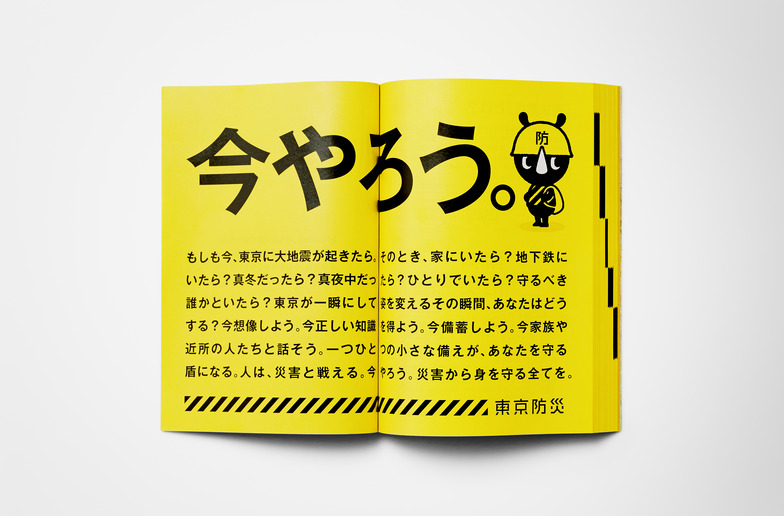
—How did you create the illustrations?
Sakaki: Illustrators were extremely important for this project, so we auditioned several. We asked them to draw on the spot: illustrations of a disaster occurring, a kitchen in disarray, pictures of emergency supplies lined up. We deliberately made it abrupt, saying, "Please draw this right now," without any prior briefing.

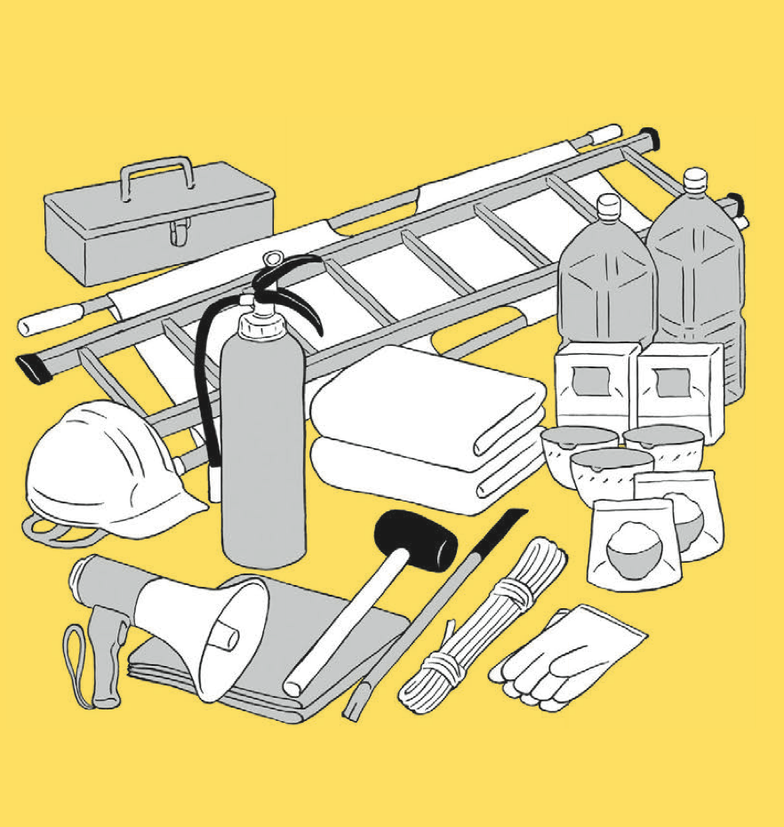
What we wanted to see here wasn't just artistic sense. We wanted to see their intuition, speed, and ability to respond to emergencies. This is because, in an actual project, they would need to produce a large volume of illustrations within two months. With many stakeholders involved, we anticipated a high volume of last-minute revisions. Speed and the ability to handle urgent requests are crucial. The illustrator selected through this audition was Yuta Okamura. He grasped our intent without needing detailed instructions and sketched it out swiftly. His consistency was invaluable.
—Not just the illustrations, but listening to you, the content seems incredibly meticulously crafted.
Sakaki: For this disaster prevention book, we consciously focused on the careful accumulation of small ideas rather than a single explosive big idea. By incorporating meticulous attention to detail and scattering small ideas throughout the entire content creation process, we aimed to make it engaging and easy to read for everyone.
I believe this was crucial for a project like this, where widespread understanding and adoption are essential. It requires instant appeal. Since the fundamental purpose differs from advertising production, it was a new challenge for me personally. We created it with deep consideration for every reader's feelings, through meticulous and careful refinement. In a way, I think it was an extremely Japanese approach. Even with the illustrations, we rewrote them multiple times. For Chapter 1, we added tension to people's expressions to evoke actual disasters, while Chapters 2 and beyond feature illustrations conveying everyday life. For the text, we incorporated checks based on the UCDA certification from the Universal Communication Design Association, repeatedly improving it to ensure it flows smoothly and conveys the message without stumbling for anyone at the junior high school level and above. The result is a disaster prevention book that is gentle on everyone. It became a Japan-originated disaster prevention book we can proudly present to the world.
−−The fact that it also addresses terrorism and pandemics became a talking point.
Sakaki: That's right. The Tokyo Metropolitan Government wanted the disaster prevention book to cover various disasters, including earthquakes, so we included those topics as well.
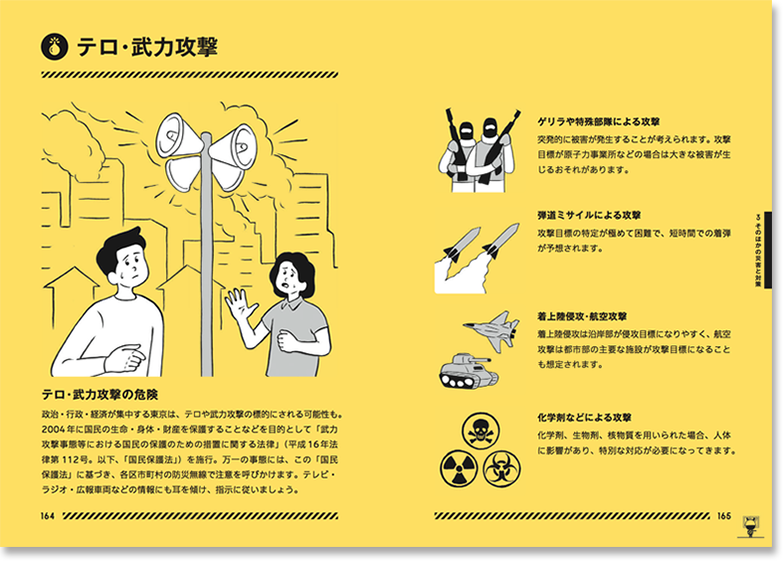
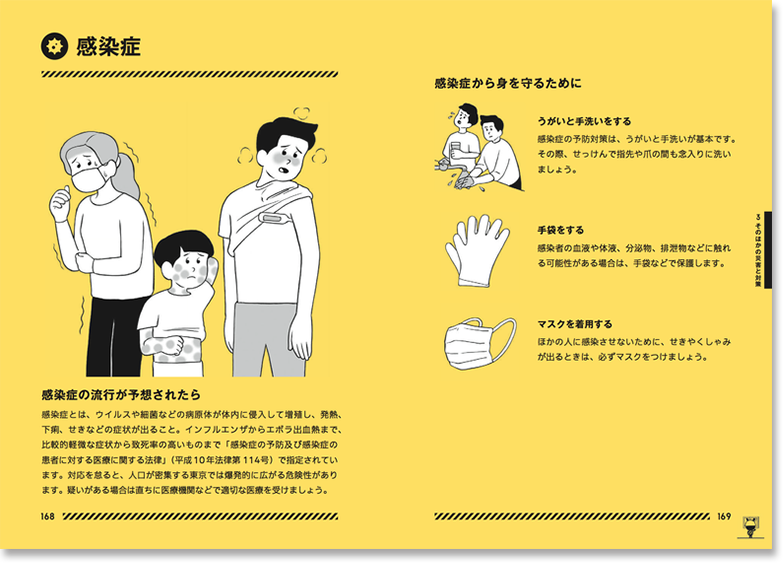
—How has the response been since distributing the book?
Sakaki: It exceeded our expectations. We anticipated some buzz, but we didn't expect it to become such a hot topic. It was featured prominently on Yahoo! Japan's homepage and covered extensively on news and information programs across various networks.
What surprised me most was the overwhelmingly positive online feedback. With large-scale public projects like this, even a small misstep can invite criticism, so I was a bit anxious. But almost all the comments were positive. People said things like, "This is the right use of tax money," "The content is easy to understand," and "The design is fantastic." It's rare to see such consistently positive online reactions.
But what felt most refreshing was hearing "Thank you." In my 12 years in advertising, I'd heard "That's interesting!" before, but "Thank you" was a first. It was the moment I felt the communication design skills I'd cultivated could be applied to solving social issues. I was genuinely happy.
—What kind of developments are you planning for disaster prevention in the future?
Sakaki: I can't share specifics about future disaster prevention projects yet, but we're preparing various next steps.
Disaster prevention involves many people working separately. I believe connecting these "points" into a "network" could create a much larger movement... That's the kind of thing I'm thinking about.
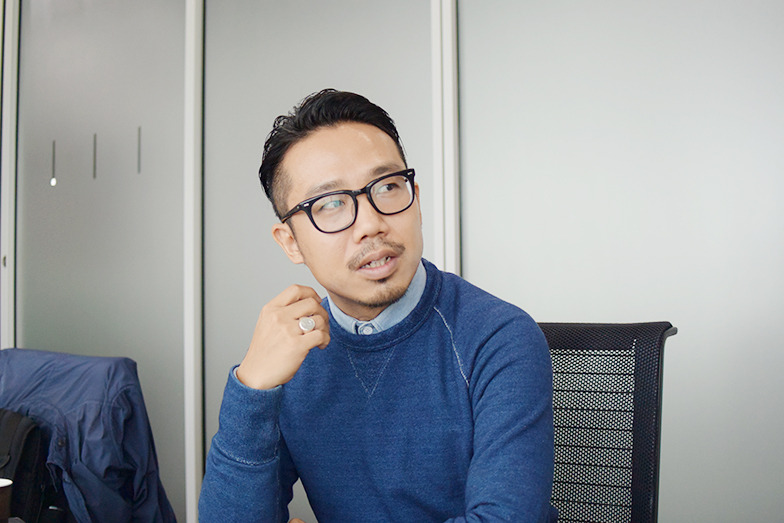
—What do you personally want to pursue going forward?
Sakaki: This time, I feel I was able to channel the skills I've accumulated through numerous client projects into solving the social challenge of disaster prevention.
We advertising creators possess a unique skill: grasping societal needs, transforming complex corporate messages into compelling content, and communicating them to disinterested audiences. I hope to see more opportunities to apply this creative power to solving societal challenges. What's needed is the ability to design communication by simultaneously imagining the perspectives of both the strategist/output creator and the recipient.
I believe this is an essential skill for creators and designers moving forward.
I intend to continue honing this skill and challenging myself to solve societal problems.
Thank you for your time today.
Was this article helpful?
Newsletter registration is here
We select and publish important news every day
For inquiries about this article
Back Numbers
Author

Sakaki Ryosuke
Dentsu Inc.
Primarily serves as an art director overseeing advertising campaigns for various companies. Currently expanding his scope with the mission to "unleash the capabilities of advertising creators for society." Recent major projects include: the data food revolution "OPEN MEALS" project, which gained attention at SXSW; the development project for "Hokkaido Ballpark," scheduled to open in 2023; the disaster prevention book "Tokyo Bousai" project, distributed to all Tokyo residents; and the space food market co-creation project "space food X." Recipient of the Good Design Gold Award and other accolades including D&AD.

